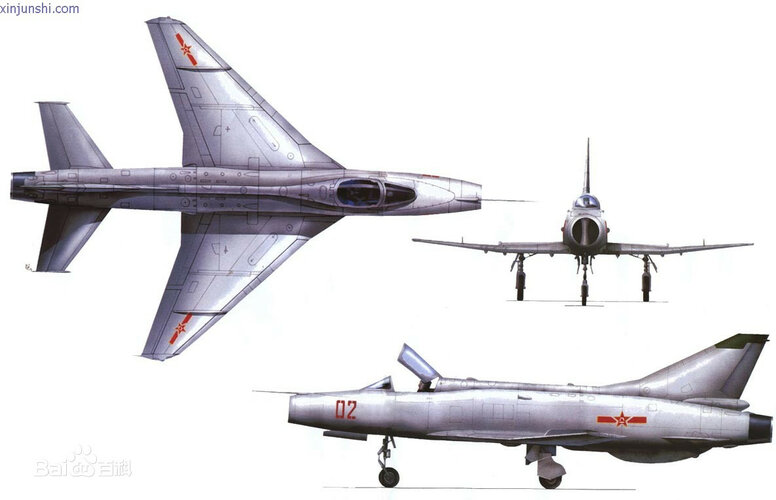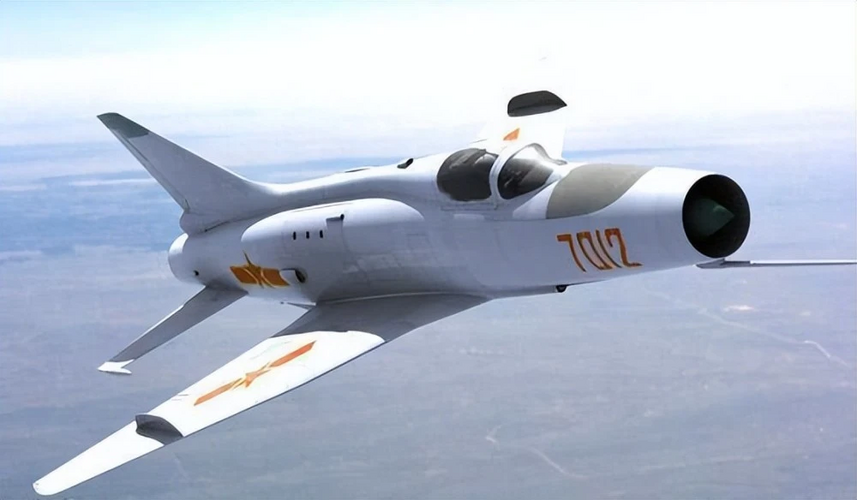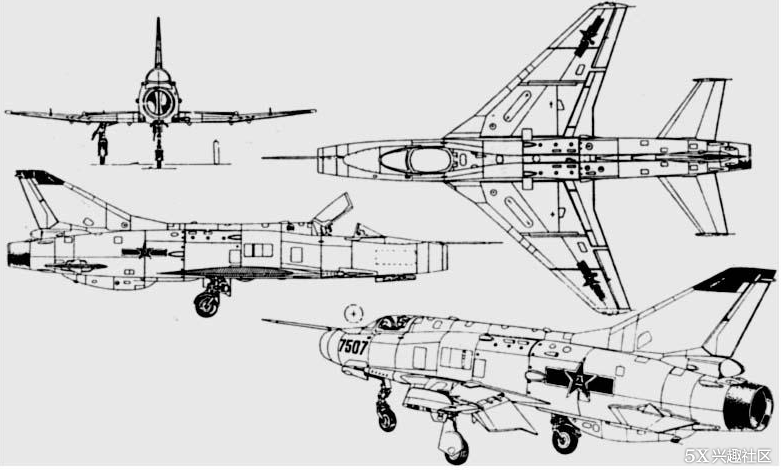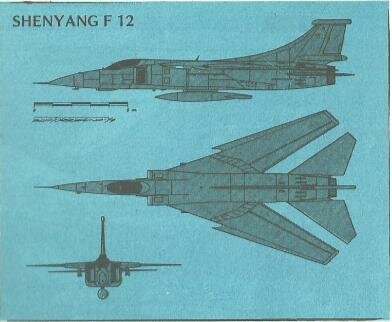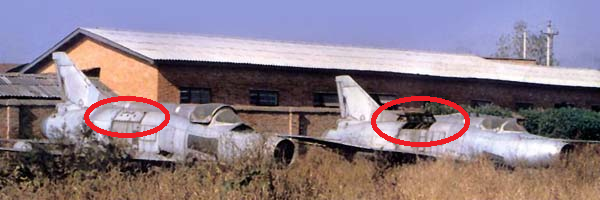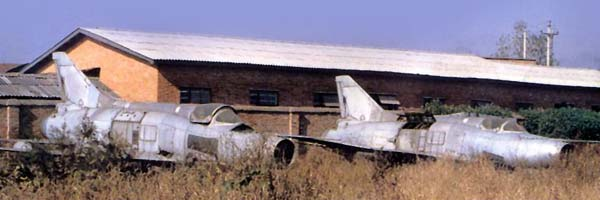You are using an out of date browser. It may not display this or other websites correctly.
You should upgrade or use an alternative browser.
You should upgrade or use an alternative browser.
Chinese Nanchang J-12 light fighter
- Thread starter F.L.
- Start date
F.L.
ACCESS: Top Secret
F.L.
ACCESS: Top Secret
thefrecklepuny
ACCESS: Confidential
- Joined
- 19 January 2008
- Messages
- 120
- Reaction score
- 87
The Chinese F-100 Super Sabre!How about a thread on the J-12 ? I noticed that there was none !
It is a jet that I like very much and I will try to collect in this thread some interesting things about it.
I started to work with Inkscape and I hope to make color profiles of J-12 under the cockades of countries where it could have flown: Sudan, Tanzania, Somalia, North Korea ....
F.L.
ACCESS: Top Secret
Isn't this rather a fictitious artist's view ?And here is a second attempt to develop or create J-12 or F-12.
I don't believe there was a "F-12II" project like this ?
Last edited:
- Joined
- 26 May 2006
- Messages
- 34,810
- Reaction score
- 15,695
Isn't this rather a fictitious artist's view ?
I don't believe there was a "F-12II" project like this ?
What ?!,it was a real project,but it's not the final one.
- Joined
- 31 July 2013
- Messages
- 568
- Reaction score
- 1,175
I believe that it is a STOL variant, which was one of the primary ideas for the project, due to the presence of the doors on the upper dorsal part of the fuselage, similar to those fitted to the Su-15VD as seen in this pic. The J-12 was initially a day fighter only with no radar provision, but later was fitted with a centre body for the same radar as the early MiG-21, which was being built in China as the J-7.First, a three view blueprint !
What is the version of the J-12 on the bottom ?
Attachments
- Joined
- 31 July 2013
- Messages
- 568
- Reaction score
- 1,175
F.L.
ACCESS: Top Secret
The J-12s "no suffix" also have these doors.
In addition, the "145 red" was a prototype of the J-12I, a variant designed to correct the problems of the J-12' s substandard performance & who first flew in 1975.
Moreover, "145 red" does not seem to have ventral nozzles.
In addition, the "145 red" was a prototype of the J-12I, a variant designed to correct the problems of the J-12' s substandard performance & who first flew in 1975.
Moreover, "145 red" does not seem to have ventral nozzles.
Attachments
Last edited:
F.L.
ACCESS: Top Secret
I am working on a text about J-12 where I am trying to compile as much information as possible...
Last edited:
actually J -12 may be more similar to Gnat, but a much more powerful versionThe Chinese F-100 Super Sabre!How about a thread on the J-12 ? I noticed that there was none !
It is a jet that I like very much and I will try to collect in this thread some interesting things about it.
I started to work with Inkscape and I hope to make color profiles of J-12 under the cockades of countries where it could have flown: Sudan, Tanzania, Somalia, North Korea ....
a light fighter jet with very good maneuverability.but also have supersonic ability
GUNDAM123dx
HAVE FUN
- Joined
- 31 October 2017
- Messages
- 62
- Reaction score
- 151
https://web.archive.org/web/20240827171805/https://user.guancha.cn/main/content?id=437765
A repost of (till-now) the most detailed and trustworthy story of the development of J-12. In Chinese.
And a J-12 vs HA-300 data chart.
(Basically 99% of people here in China consider J-12 as the lightest supersonic jet fighter - as the article title in the link above, cuz few knows the HA-300.)
A repost of (till-now) the most detailed and trustworthy story of the development of J-12. In Chinese.
And a J-12 vs HA-300 data chart.
(Basically 99% of people here in China consider J-12 as the lightest supersonic jet fighter - as the article title in the link above, cuz few knows the HA-300.)
Attachments
Last edited:
GUNDAM123dx
HAVE FUN
- Joined
- 31 October 2017
- Messages
- 62
- Reaction score
- 151
See post#13I am working on a text about J-12 where I am tryingto compile as much information as possible...
F.L.
ACCESS: Top Secret
Wahoo, what a great article !See post#13I am working on a text about J-12 where I am tryingto compile as much information as possible...
This article says there were planned stealth and carrier based versions of the j-12. No idea how credible it is though
update: it was only a proposal by the designer of the q-5 and some other aircraftThis article says there were planned stealth and carrier based versions of the j-12. No idea how credible it is though

Nanchang J-12 - Wikipedia
Could it have success in export market
Have any appreciable advantage over MiG-21
CV12Hornet
ACCESS: Top Secret
- Joined
- 8 January 2021
- Messages
- 505
- Reaction score
- 1,148
I mean, it died in favor of the J-7, so the answer is no and no.
- Joined
- 27 December 2005
- Messages
- 17,706
- Reaction score
- 26,136
If China didn't see any advantage, I don't think anyone else would?
Last edited:
The j-12 Just came a little to late, If you told me this was a from the mid 50's (so during the same period as the mig-19 or f-100) then I would think it's a great aircraft. But the only thing it has on the mig-21 is cost (it's after all gust a one engine mig-19) and the mig-21 was already an extremely cheep aircraft.
Airborne2001
ACCESS: Secret
- Joined
- 19 June 2020
- Messages
- 224
- Reaction score
- 277
Dilandu
I'm dissatisfied, which means, I exist.
Basically the idea was, that well-dispersed and camouflaged force of light interceptors would be able to hamper enemy superior air forces by performig individual daylight hit-and-run attacks. It would force the enemy to be cautious and defensive, escorting its strike wings with fighters (which, over the wast areas of China would not be easy). Likely they took inspiration from North Vietnam fighters - which mere existence created a lot of troubles for Americans.I found this source (I used Google Translate in the tab) with a rather fascinating note about the J-12s intention, that being "aerial guerilla warfare". A short takeoff distance combined with the ability to operate from rough surfaces like roads to due guerilla combat, but in the sky? An interesting proposal that I am not too sure would've worked well, but fascinating nonetheless. Maybe similar to aircraft like the Cessna Skymaster in Vietnam, but a jet fighter? I don't know how to view it.
Scott Kenny
ACCESS: USAP
- Joined
- 15 May 2023
- Messages
- 11,327
- Reaction score
- 13,809
I'd argue that what caused problems for the Americans in Vietnam was the Rules of Engagement requiring a positive visual ID of an aircraft before they could engage. No long-range shots with Sparrows.Basically the idea was, that well-dispersed and camouflaged force of light interceptors would be able to hamper enemy superior air forces by performig individual daylight hit-and-run attacks. It would force the enemy to be cautious and defensive, escorting its strike wings with fighters (which, over the wast areas of China would not be easy). Likely they took inspiration from North Vietnam fighters - which mere existence created a lot of troubles for Americans.
In an environment where that's not the case, the US would fare a lot better in dealing with opposing aircraft.
Dilandu
I'm dissatisfied, which means, I exist.
True, but Chinese worked from what they knew. They presumed that in case of war with either USA or USRR (or both) their small and outdared PLAAF would be in essentially the same position as Vietnamese against USAF. And they tried to extrapopate from that experience.In an environment where that's not the case, the US would fare a lot better in dealing with opposing aircraft.
Ainen
I really should change my personal text
- Joined
- 25 August 2011
- Messages
- 1,233
- Reaction score
- 1,633
But what's the difference?I'd argue that what caused problems for the Americans in Vietnam was the Rules of Engagement requiring a positive visual ID of an aircraft before they could engage. No long-range shots with Sparrows.
In an environment where that's not the case, the US would fare a lot better in dealing with opposing aircraft.
It's absolutely same situation as over North Vietnam, clustered air picture is the best way to prevent BVR engagement.
The problem wasn't concert per se(arguably Gripen was and still is built to do the exact same thing), problem was J-12 was born hopelessly outdated.
Dilandu
I'm dissatisfied, which means, I exist.
It could be argued that in case of major war with nuclear power - such as China - the USAF would be more willing to accept losses from friendly fire, if it would lead to more damage inflicted to the enemy.It's absolutely same situation as over North Vietnam, clustered air picture is the best way to prevent BVR engagement.
Lu xiaopeng,The designer of the J12 had a very tumultuous life. In the 1940s, he studied and worked at McDonnell in US and Gloster in UK.After 1949, he joined the aviation industry in Communist China. However, he was never fully trusted by the Communist Party and was only assigned secondary tasks. Political factors also played a significant role in the ultimate failure of the J12. His most important achievement was the Q5 attack aircraft, which was developed based on the MiG-19. Additionally, he worked on the Q6 variable-sweep wing attack aircraft, which was never realized.
Given its limited capabilities, the Chinese Air Force always believed that in the event of a large-scale war with the Soviet Union, a large number of agile and cost-effective fighter jets would be needed to conduct so-called "people’s war" and "guerrilla warfare." This obsession with lightweight fighters persisted until the mid-1980s. Even in the 1980s, Gu Yongfen, the chief designer of the J-8, conceived a single-engine light fighter and attempted to propose it to Air Force leaders. However, with the end of the Cold War, everything changed.
Airborne2001
ACCESS: Secret
- Joined
- 19 June 2020
- Messages
- 224
- Reaction score
- 277
Did he by chance ever work on the CXP-1001?Lu xiaopeng,The designer of the J12 had a very tumultuous life. In the 1940s, he studied and worked at McDonnell in US and Gloster in UK.After 1949, he joined the aviation industry in Communist China. However, he was never fully trusted by the Communist Party and was only assigned secondary tasks. Political factors also played a significant role in the ultimate failure of the J12. His most important achievement was the Q5 attack aircraft, which was developed based on the MiG-19. Additionally, he worked on the Q6 variable-sweep wing attack aircraft, which was never realized.
This would explain the abundance of light and cost-effective Chinese fighter designs I've run into on the internet. I think this was a smart proposal given the circumstances.Given its limited capabilities, the Chinese Air Force always believed that in the event of a large-scale war with the Soviet Union, a large number of agile and cost-effective fighter jets would be needed to conduct so-called "people’s war" and "guerrilla warfare." This obsession with lightweight fighters persisted until the mid-1980s. Even in the 1980s, Gu Yongfen, the chief designer of the J-8, conceived a single-engine light fighter and attempted to propose it to Air Force leaders. However, with the end of the Cold War, everything changed.
Yes, according to the official biography of Lu Xiaopeng, while he was in Gloster, he participated in the design of the CXP-1001 and was responsible for the overall design plan. However, the leader of the Chinese design team later excluded him from the overall design team and reassigned him to tail design, which left him very disappointed and saddened.I personally speculate that this experience was also one of the important reasons why he later chose to go to the mainland instead of Taiwan.Did he by chance ever work on the CXP-1001?
This would explain the abundance of light and cost-effective Chinese fighter designs I've run into on the internet. I think this was a smart proposal given the circumstances.
Scott Kenny
ACCESS: USAP
- Joined
- 15 May 2023
- Messages
- 11,327
- Reaction score
- 13,809
I'm not sure that's a good understanding of how air combat works, but when absolutely everything must be written with the correct Communist ideology...Given its limited capabilities, the Chinese Air Force always believed that in the event of a large-scale war with the Soviet Union, a large number of agile and cost-effective fighter jets would be needed to conduct so-called "people’s war" and "guerrilla warfare." This obsession with lightweight fighters persisted until the mid-1980s. Even in the 1980s, Gu Yongfen, the chief designer of the J-8, conceived a single-engine light fighter and attempted to propose it to Air Force leaders. However, with the end of the Cold War, everything changed.
Dilandu
I'm dissatisfied, which means, I exist.
Frankly, the main reason was that China was finally able to start a Chengdu J7 (a Mig-21 derivative) mass production by 1970s, and those Mach 2 fighters were just better than Nanchang J-12, while not being too costly and complicated. The J-12 was left without a clear function; producing additional light fighter with limited performance "just to have it" was too expensive for China.Political factors also played a significant role in the ultimate failure of the J12.
Dilandu
I'm dissatisfied, which means, I exist.
It was more a case of "something that MIGHT work against overwhelming odds". As I mentioned above, PLAAF concluded out of Vietnam War experience, that large airbases would likely be relatively quickly attacked and destroyed by much superior American or Soviet aviation. So they hoped to counter the superior opponent by dispersing a large number of light fighters on well-camouflaged positions - so they could not be taken out at once while on land - and use them as ambush force, that would pop-up, strike a convenient target & run away. The main idea was, that the mere possibility of such attack would force the opponent to be more cautious, provide his strike groups with heavy escorts and thus seriously hinder his operations.I'm not sure that's a good understanding of how air combat works, but when absolutely everything must be written with the correct Communist ideology...
It wasn't exactly good idea, but at the time it was suggested the best fighter that PLAAF have in anything like sufficient numbers was a Mig-19 clone. So... it was a case of "either that, or nothing".
Similar threads
-
Shenyang Jianjiji-11 / J-11 Lightweight Fighter
- Started by Deino
- Replies: 11
-
-
-
SAC J-XX Competitor designs - "Snowy Owl" 雪鸮 etc.
- Started by Woody
- Replies: 38
-

